Courage Center Handiham World Weekly E-Letter for the week of Wednesday, 20 February 2013
This is a free weekly news & information update from Courage Center Handiham System. Our contact information is at the end, or simply email handiham@couragecenter.org for changes in subscriptions or to comment. You can listen to this news online.
MP3 audio stream:
http://www.handiham.org/audio/handiham.m3u
Download the 40 kbs MP3 audio to your portable player:
http://www.handiham.org/audio/handiham.mp3
Get this podcast in iTunes:
http://www.itunes.com/podcast?id=372422406
RSS feed for the audio podcast if you use other podcasting software:
http://feeds.feedburner.com/handiham
Welcome to Handiham World.
Remote Base Report
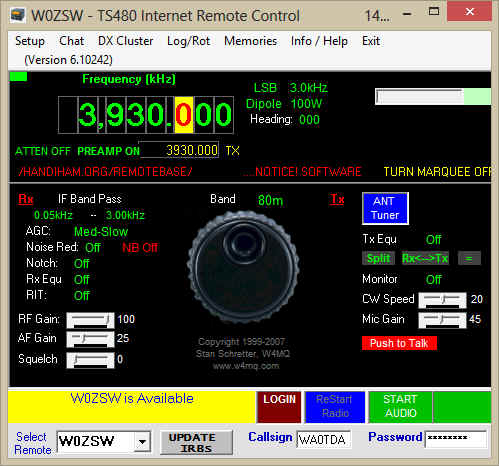
We lead off this week with a report on what is happening with the Internet Remote Base project. This is because we have made really good progress with the software, and also because we have to explain why this whole process is not as straightforward as you might think.
First, a summary of what it is. The Handiham System operates two internet-enabled high-frequency amateur radio stations, W0EQO and W0ZSW. These club stations consist of Kenwood TS-480 transceivers interfaced to computers that are always running and connected to the internet. Approved users can log into either of the stations and control the radios, both for transmit and receive, and get on the air. This remote control operation allows users who cannot get on the air with their own stations, perhaps because they have no room for antennas, to enjoy HF amateur radio operating from a real HF station.
The rig control software is available from the Handiham website, but that wasn't always the case. It was kindly shared with us by Stan, W4MQ, the software author, because he wanted to see that it would be updated and continue to be available free of charge to amateur radio operators everywhere even though he would no longer be doing the updating. Bob, N2JEU, had taken over this task before we came on board - but sadly, Bob became a silent key before he could reach his goal. It was shortly after that when we approached Stan for permission to work directly with the software. A long time has passed, but we have made solid progress and have released our first update this past January. A software development team led by programmer Jose Tamayo, KK4JZX, is responsible for managing the software.
When the January software release was made available, it solved several serious problems, including delays in the software's response to commands. That delay could be very annoying when operating on the air. Unfortunately we did not realize that we had broken the CW filter system, leaving our CW users with only a very narrow 50 Hz filter, effectively killing Morse code operation! That will be fixed in the next release, as will a number of other things on our task list. I mention this because it is always hard to work with something as complicated as software. Even commercial software developers hit bumps in the road and have to send fixes and updates to their customers. We appreciate hearing from you whenever you find something wrong or if you have a suggestion to make something better.
But the software, although it is our major effort right now, is only a part of the remote base picture. The hardware - the stations themselves - are themselves complex installations that sometimes require intervention. The usual tasks are editing the station configuration files to add new users or to change something about how the station operates, rebooting the W4MQ host software, updating other software - including Windows - and just making sure that everything is still working. Outdoors, the stations have antennas that must stay up and in good condition in spite of snow, ice, wind, rain and whatever else the weatherman throws our way! One recent improvement was the mitigation of RFI from a nearby plasma TV set at the W0ZSW location. When you are responsible for stations like these, there is always something going on. It is not a "set it and forget it" type of operation, and we depend on users to tell us when something is not working right.
Another important but sometimes overlooked part of the Internet Remote Base project is the website support pages. Since we are a small team, we have little time to work closely with individual users who need tech support. That is where the website can help to answer user questions and guide them in everything from installation and setup to problem-solving later on. Here is a partial diagram of how the oldest part of the website support pages are organized.
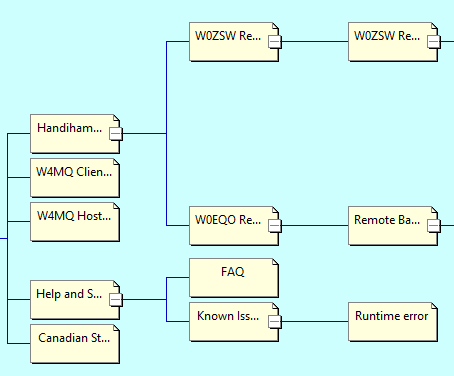
Doing the website work is my job, and others contribute some of the text. Since our first station came on line in 2009, the website has been around in one form or another to help users get started. The problem is that as our remote base operations changed and grew, we kept adding to the old website. Now that website has outdated information, and worse still, it is difficult to navigate and find what you want. This was brought home to me recently when I went to look for some information myself and had a hard time figuring out where to go. This means that it is time to bring the Remote Base website up to a higher standard. We will be working to move all of the information from a static directory on Handiham.org to a database-enabled Wordpress site at
http://handiham.org/remotebase/. This will make it easier to manage the information we put on the site and keep it up to date. In the current system we have too many things to manage, and sometimes information appears in two different places. Whenever that happens, there is always the danger that one page will say something different than the other. Having everything in one place will add much more reliability to the site and an additional bonus will be a search field that will help users find what they want more quickly.
So to sum up, we are working in three major areas:
- Software development, maintenance, and testing
- Hardware and station maintenance
- Support and website services
This is not a trivial amount of effort! And when you consider that none of it even existed prior to 2008, when planning began, it is all the more impressive to see what our team has accomplished. As we move forward, we must manage our resources - business talk for not biting off more than we can chew. This will mean limiting the user base to being primarily a Handiham service, even though we do regularly get requests for Remote Base access from nonmembers. This will have to extend to tech support as well. It makes sense to ration our time helping members rather than someone who is not a member. On the other hand, since we do honor the spirit of Amateur Radio in helping each other whenever possible, we might consider some more interactive support solution such as a Yahoo Group for the remote base, which was suggested by Eliot, KE0N. Such a support group would be a place to post questions and solutions about remote base operation so that users would have a place to go for help no matter where they live and whether or not they are Handiham members. Of course we will also have the
Remote Base website, which will be available to anyone for information and support.
Next, you see a photo of the W0ZSW remote base station itself, showing the TS-480HX transceiver, two Samlex SEC switching power supplies, the Systemax rig control computer, and the LDG AT-200PRO automatic antenna tuner. Both of our stations use
RIGblaster interfaces to connect the radios to the computers.

You may be wondering why there are two of the
SEC 1235M power supplies instead of just one, as you would find in a typical station. Each supply can deliver 30 amps, but the
Kenwood TS-480HX radio requires more current when operating at full power. The usual solution is to use two "regular" power supplies as we have done, but you can also use a single supply if it is capable of delivering over 40 amps. One of the changes coming with the newest software upgrade will be 200 watt operation on several bands. We had only been able to use the TS-480HX at 100 watts because that is the highest power level setting in the old version of the rig control software.
Antenna tuning is a potential problem with any club station, where you are going to have a number of different operators with different skill levels and different goals in where and how they want to operate. One person will want to operate 40 meter CW. Another will try snagging new contacts on 6 meter SSB. The antenna at the W0ZSW station is a 200 foot long "W0OXB Special", which is a type of double extended zepp wire antenna fed in the center with 450 ohm ladder line running to a current balun and then to 50 ohm coax and an antenna tuner. The tuner must be retuned every time the station's frequency is changed substantially, and you can't depend on every user to be able to do that consistently and accurately. That's why we chose an automatic antenna tuner, the
LDG AT-200 Pro, to put in the coaxial line between the TS-480HX and the current balun. This excellent and reliable tuner tunes itself automatically when RF is applied at transmit. No other user intervention is required, making it about as foolproof as we can manage. It is worth mentioning here that the radio does not even have its own internal antenna tuner as some do. The TS-480HX (High Power) model gives up the internal antenna tuner available in the 100 watt TS-480SAT in order to fit in the larger amplifier components. In the future, we may make antenna improvements or add a second antenna, which is supported by the software. W0ZSW is located in Woodbury, Minnesota, east of the Twin Cities metropolitan area and not far from the Wisconsin border. Its grid square is EN34mv.
Here is a picture of the W0EQO remote base station at Courage North, in Northern Minnesota's pine forest and lake country, located in grid square EN27me. This is close to the headwaters of the Mississippi River. The station is a
Kenwood TS-480SAT transceiver, a single Samlex power supply for 100 watt operation, an
LDG AT-100 Pro automatic antenna tuner, and the rig control computer. The station is in an unheated equipment room in a region where outside temperatures can reach below minus 30 degrees Fahrenheit (-34 C.) Outdoors, the northern lights flash through the sky on dark star-filled nights and bears and wolves roam the woods. Needless to say, there is not a lot of urban RF interference here and the station is considered to be in a quiet location.
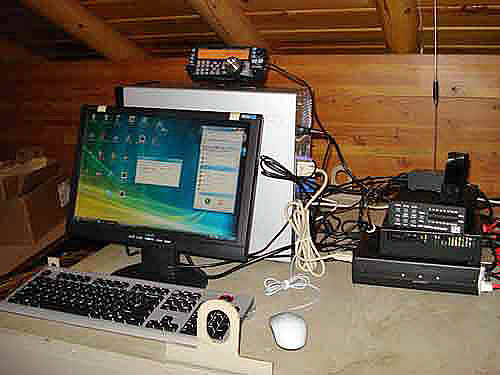
The antenna at W0EQO is a 125 foot G5RV, which is strung between two tall pine trees. Because the antenna will not tune on all bands, this station cannot be used on 160 or 6 meters. Neither station will transmit on 60 meters, although receiving is allowed anywhere the radio's frequency can be set. Although the radio does have an internal antenna tuner, this feature is disabled and the antenna is tuned automatically by the external LDG tuner as soon as RF is applied on transmit. The LDG matches a wider range than the internal tuner and does not require any special operator intervention.
The Remote Base health report for today is a good one: W0EQO and W0ZSW are both on line and there are no scheduled outages. Please join me in thanking our remote base team volunteers for their wonderful effort!
Patrick Tice, WA0TDA
Handiham Manager
Correspondence:

Jose, KK4JZX, writes:
To Handiham Members and Volunteers,
We are making progress and continuing to work on enhancing the remote base client software. The Remote Base Beta team has been working diligently in testing some very exciting fixes and features that will be released soon. If you have suggestions for improving the remote base client software, let us know and we will add your suggestions to the list. The sooner you get your suggestion in, the sooner you might see it in a future update. Want a peek at what’s coming up? Well, stay tuned as we continue to work to release the next version which will include fixes for the default browser issue and many more enhancements.
Thank you and enjoy. 73: KK4JZX
Ken, KB3LLA, passes along an invitation to visit Sendero Group at CSUN:
Join Sendero at CSUN 2013 in San Diego, February 27 - March 1 when we unveil what many of you have been eagerly awaiting!
What's new:
* Demonstrating the fully accessible turn-by-turn GPS iPhone application, The Seeing Eye GPS, in the Sendero Suite and at the booth.
* Announcing Sendero PC GPS, now you can run Sendero GPS as well as the virtual maps on your Windows laptop, ultrabook or tablet.
* Calling for testers, Sendero is conducting research on a People Finder application made possible by a grant from the Department of Education.
* Releasing 2013 Maps for BrailleNote, Braille Sense and Mobile Geo.
Visit http://senderogroup.com/news/csunform.asp to sign up and join in the fun!
Jim, KJ3P, writes about his volunteer recordings for the monthly DAISY digest, enjoyed by our blind members:
As always, I welcome your feedback, especially regarding the number and choice of articles.
73,
Jim Perry, KJ3P
Editor's Note: You may email us at
handiham@couragecenter.org and we will pass your comments on to Jim and to our other reading volunteers.
Avery, K0HLA, recalls the Postal Service's delivery schedule in the old days:
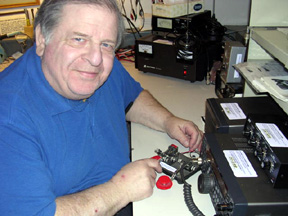
Seems to me that when I was a young lad:
1) Post cards were a penny
2) Letters were 3 cents
3) There was no postal delivery on Saturdays to non-business addresses.
4) There was delivery on Saturdays only to business and emergency organizations like fire, police, hospitals, etc.
So, this NEW "no delivery on Saturdays" is not new. What is the big deal ?
73 & DX de K0HLA Avery
( CW Forever )
Mike, W1MWB, responds to the call for a new Worked All States challenge:
I think an IRB and conference-based WAS challenge would be a good thing. For example, just the other day I heard a station in NH calling for the NH QSO party. It was AF1T, whom I worked on 2 meter simplex. However, on 20 meters I could not get through the pileup as he was probably a bit too close geographically. If I had been on one of the handiham IRBs I would have most likely been able to make the contact, so I think utilizing the IRBs would be a good thing, and as you said, using the *HANDIHAM* server and associated systems would be good practice for new folks coming into the hobby. I look forward to hearing more on this.
73 for now,
Mike, W1MWB
Tom, KB3HG, writes about how people need to listen more during contests:
Good Humor for the contest, but didn't MN just have a QSO party of late? I tried to make contact; have a Boy Scout with me. What a bunch of contest alligators - all mouth and no ears, they never shut up. I'm a Delaware station and wanted to give a few contacts away. Not a chance; not 5NN so no returns. A mighty poor showing for a scout to see. If I get one scout started it will go to five or more real quick. I have managed to generate interest in the radio merit badges and now the new ribbon for the scouts.
Tom, KB3HG
FM29CQ
Newark, DE 19711
Editor's note: How many times have we mentioned in this very publication how important it is to listen? It bites to realize you might have worked Delaware had you only taken the time to listen carefully!
Handiham Nets are on on the air.
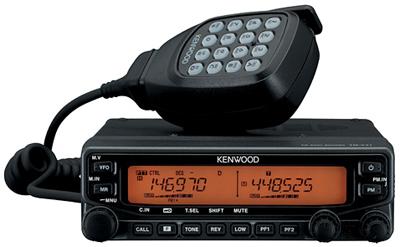
We are on the air daily at 11:00 USA Central Time, plus Wednesday & Thursday evenings at 19:00 USA Central Time.
The official and most current net news may be found at:
http://www.handiham.org/nets
Daily sessions:
Monday through Saturday 11:00 AM social net with designated net control station. Everyone is welcome to check in.
Sunday morning 11:00 AM informal Roundtable with no net control station or designated topic. Check in with your friends and enjoy a Sunday morning chat!
Evening sessions:
Wednesday evening Handiham Radio Club Social Net with a trivia question. This is a friendly, directed net with a net control station and the opportunity to answer a trivia question, if you wish.
Thursday evening Handiham Radio Club TechNet, a directed net with a net control station for the purpose of discussing technical topics in amateur radio. If you have a question or a technical problem, check in and report it to the net. Perhaps you will find an answer in the ensuing discussion, or perhaps you will be able to answer someone else's question about a technical issue.
EchoLink nodes:
Welcome to the NX0P repeater, 146.685 with a tone of 100Hz, Echolink node number 513917. The NX0P machine is near Albert Lea in far southern Minnesota, near the busy intersection of US Interstate highways 90 and 35.
*HANDIHAM* conference server Node 494492 (Our preferred high-capacity node.)
*VAN-IRLP*, node 256919
KA0PQW-R, node 267582
KA0PQW-L, node 538131
N0BVE-R, node 89680
On the 220 MHz band: 223.94 negative offset, Arden Hills, MN Tone 100 Hz - KA0PQW (link)
Other ways to connect:
IRLP node 9008 (Vancouver BC reflector)
WIRES system number 1427
A dip in the pool
 It's time to test our knowledge by taking a dip in the pool - the question pool, that is!
It's time to test our knowledge by taking a dip in the pool - the question pool, that is!
Let's go to the Extra Class pool and look at a question about power supplies:
E7D17 asks, "What is the primary reason that a high-frequency inverter type high-voltage power supply can be both less expensive and lighter in weight than a conventional power supply?"
Possible choices are:
A. The inverter design does not require any output filtering.
B. It uses a diode bridge rectifier for increased output.
C. The high frequency inverter design uses much smaller transformers and filter components for an equivalent power output.
D. It uses a large power-factor compensation capacitor to create “free power” from the unused portion of the AC cycle.
The reason I chose this question is that it refers to what are commonly called "switching" power supplies, or "switchers". These are the supplies we use at both Handiham Internet Remote Base installations. The reason these supplies can be so much smaller and lighter in weight than conventional supplies is that they do not need huge, heavy transformers. The correct answer is C: The high frequency inverter design uses much smaller transformers and filter components for an equivalent power output. Conventional designs operate at 60 Hz, the power line frequency, and their components need to be enormous by comparison to operate at such a low frequency. One advantage of the conventional design is that it is not likely to generate any interference in the HF range, as is common in switching designs. Most modern switchers have RFI suppression built in, and sometimes include a way to tune an interfering signal away from the ham bands.
Please e-mail
handiham@couragecenter.org to comment.
This week @ HQ
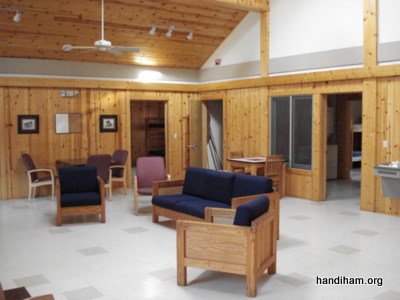
Photo: The great room in a typical wheelchair-accessible cabin at Radio Camp. Each cabin sports a complete kitchen for snacks and a laundry.
Radio Camp application packets will be ready for mailing soon. 2013 camp dates call for arrival on July 28 and departure on August 2. We have confirmed that we will offer our campers who pass Technician at camp brand-new handheld radios. Radio camp will emphasize ham radio fun and getting on the air.
We will feature:
- Technician beginner small group class - Get your first license and get on the air!
- General Class study group for those who need a quick review before taking the General exam.
- Extra Class study group for those who need a quick review before taking the Extra exam.
- VE session conducted by SARA, the Stillwater (MN) Amateur Radio Association, on Thursday, August 1, at 1:30 PM.
- Operating Skills small group get on the air sessions and discussions
- Extra Class seminar for those with Extra Class licenses who want to participate in more advanced technical projects and discussions
- Several stations to operate, including maritime mobile on the camp pontoon boat with Cap'n Bill, N0CIC
- Sailing with Skipper Bill, K9BV
- Handiham Radio Club meeting and elections
- Dining in the nearby newly-remodeled Woodland dining hall.
- Fun in the sun during Minnesota's excellent summer season - at Camp Courage on beautiful Cedar Lake!
For a Radio Camp application, email Nancy at
hamradio@couragecenter.org or call her at 763-520-0512.
Our Remote Base Health Report will move to its new home on the Wordpress site this week. If you have been in the habit of checking the daily remote base report, you will soon find it at its new home.
Our scheduled Extra Class lecture this week will cover digital logic and will be available on Friday afternoon if all goes well. Due to the lack of time, I was unable to post this lecture last week. All courses, Tech though Extra, are on line for your use whenever you want to study or review. Teaching is done with thoughtful attention to descriptions for those who are blind, and we promote understanding concepts rather than simply memorizing the question pool. If you would like to use this service but do not understand how, please contact us. We can also put the audio lectures on your DAISY digital NLS cartridge if you prefer that method instead of downloading or streaming audio from the website. Our latest audio lectures cover concepts in the Extra Class course. Please join us in whatever course you need, and also please let us know if you would like a specific topic covered in our Operating Skills lecture series.
Handiham net information and news: The official and most current net news may be found at:
http://www.handiham.org/nets
Digital mailers are important: If you do mail a digital cartridge to us, please be sure that it is an approved free matter mailer. Otherwise it will quickly cost us several dollars to package and mail out, which is more than the cost of the mailer in the first place. We don't have a stock of cartridges or mailers and not including a mailer will result in a long delay getting your request back out to you.
DAISY audio digests are available for our blind members who do not have computers, playable in your Library of Congress digital player. Handiham members who use these players and who would prefer to receive a copy of the monthly audio digests on the special Library of Congress digital cartridge should send a blank cartridge to us in a cartridge mailer (no envelopes, please), so that we can place the files on it and return it to you via free matter postal mail. Your callsign should be on both the cartridge and the mailer so that we can make sure we know who it's from. Blank cartridges and mailers are available from
APH, the American Printing House for the Blind, Inc.
Digital Talking Book Cartridge Catalog Number: 1-02610-00, Price: $12.00
Digital Talking Book Cartridge Mailer Catalog Number: 1-02611-00, Price: $2.50
Order Toll-Free: (800) 223-1839.
The Library of Congress NLS has a list of vendors for the digital cartridges:
http://www.loc.gov/nls/cartridges/index.html
Get it all on line as an alternative: Visit the DAISY section on the Handiham website after logging in.
Stay in touch

Be sure to send Nancy your changes of address, phone number changes, or email address changes so that we can continue to stay in touch with you. You may either email Nancy at hamradio@couragecenter.org or call her at 763-520-0512. If you need to use the toll-free number, call 1-866-426-3442.
Handiham Manager Patrick Tice, WA0TDA, may be reached at handiham@couragecenter.org or by phone at 763-520-0511.
Mornings Monday through Thursday are the best time to contact us.
The Courage Handiham System depends on the support of people like you, who want to share the fun and friendship of ham radio with others. Please help us provide services to people with disabilities. We would really appreciate it if you would remember us in your estate plans. If you need a planning kit, please call. If you are wondering whether a gift of stock can be given to Handihams, the answer is yes! Please call Walt Seibert, KD0LPX, at 763-520-0532 or email him at walt.seibert@couragecenter.org.
Call 1-866-426-3442 toll-free. -- Help us get new hams on the air.
Get the Handiham E-Letter by email every Wednesday, and stay up-to-date with ham radio news.
You may listen in audio to the E-Letter at Handiham Weekly E-Letter in MP3 format
Email us to subscribe:
hamradio@couragecenter.org
That's it for this week. 73 from all of us at the Courage Handiham System!
Pat, WA0TDA
Manager, Courage Handiham System
Reach me by email at:
handiham@couragecenter.org
Nancy, Handiham Secretary:
hamradio@couragecenter.org
ARRL is the premier organization supporting amateur radio worldwide. Please contact Handihams for help joining the ARRL. We will be happy to help you fill out the paperwork!
The weekly e-letter is a compilation of software tips, operating information, and Handiham news. It is published on Wednesdays, and is available to everyone free of charge. Please email handiham@couragecenter.org for changes of address, unsubscribes, etc. Include your old email address and your new address.





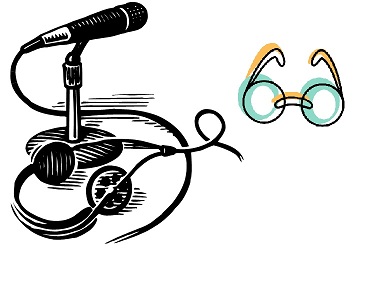
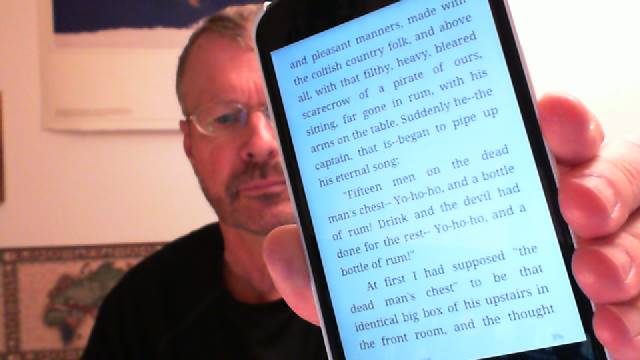



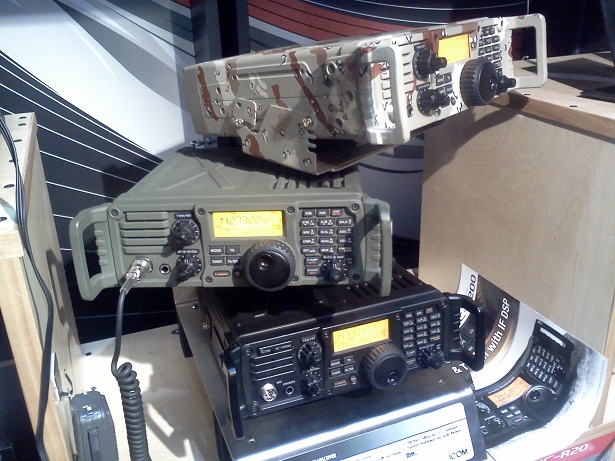
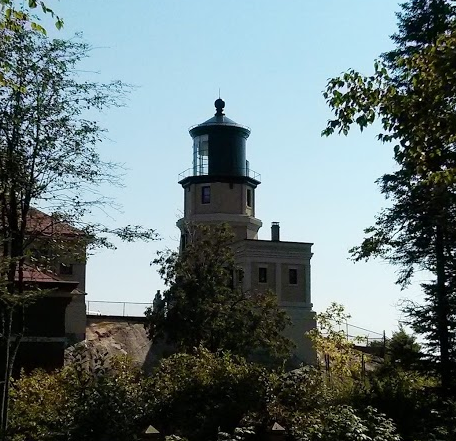
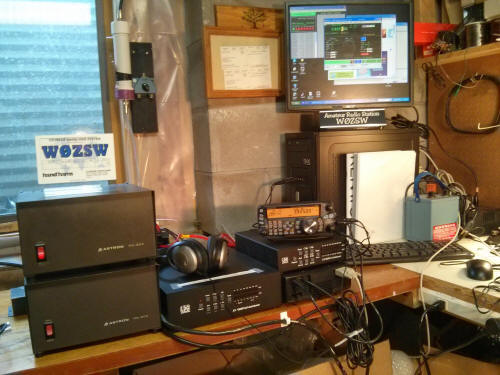
 But there it is: The days are getting shorter and that means we will slide quickly down the
But there it is: The days are getting shorter and that means we will slide quickly down the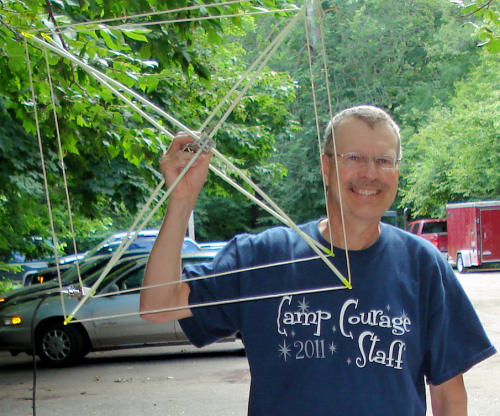

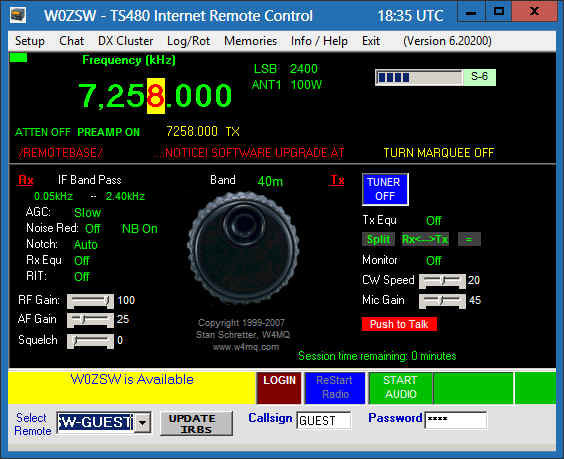


 Photo: The great room in a typical wheelchair-accessible cabin at Radio Camp. Each cabin sports a complete kitchen for snacks and a laundry.
Photo: The great room in a typical wheelchair-accessible cabin at Radio Camp. Each cabin sports a complete kitchen for snacks and a laundry. 





